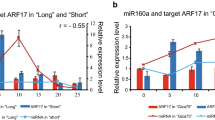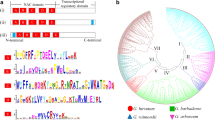Abstract
Cotton (Gossypium hirsutum L.) is an important crop that is used to produce both natural textile fiber and cottonseed oil. Cotton fiber is a unicellular trichome, whose length is critical to fiber quality and yield but difficult to modify. FCA was originally identified based on flowering time control in Arabidopsis. The function of the second RNA recognition motif (RRM) domain of Oryza sativa FCA in rice cell-size regulation has been previously reported, showing it to be highly conserved across dicotyledonous and monocotyledonous plants. The present study showed that the second RRM domain of Brassica napus FCA functioned in Gossypium hirsutum, leading to enlargement of multiple cell types, such as pollen, cotyledon petiole, and cotton fiber. In the resulting transgenic cotton, fiber length increased by ~10% and fiber yield per plant showed a dramatic increase, ranging from 35 to 66% greater than controls. Thus, this RRM domain may be a cell-size regulator and have great economic value in the cotton industry.




Similar content being viewed by others
References
Altpeter F, Baisakh N, Beachy R, Bock R, Capell T, Christou P, Daniell H, Datta K, Datta S, Dix PJ (2005) Particle bombardment and the genetic enhancement of crops: myths and realities. Mol Breed 15(3):305–327
Arpat A, Waugh M, Sullivan J, Gonzales M, Frisch D, Main D, Wood T, Leslie A, Wing R, Wilkins T (2004) Functional genomics of cell elongation in developing cotton fibers. Plant Mol Biol 54(6):911–929
Attia K, Li K, Wei C, He G, Su W, Yang J (2005) Transformation and functional expression of the rFCA-RRM2 gene in rice. J Integr Plant Biol 47(7):823–830
Baurle I, Dean C (2008) Differential interactions of the autonomous pathway RRM proteins and chromatin regulators in the silencing of Arabidopsis targets. PLoS One 3(7):e2733
Baurle I, Smith L, Baulcombe D, Dean C (2007) Widespread role for the flowering-time regulators FCA and FPA in RNA-mediated chromatin silencing. Science 318(5847):109–112
Bedinger P (1992) The remarkable biology of pollen. Plant Cell 4(8):879–887
Burd C, Dreyfuss G (1994) Conserved structures and diversity of functions of RNA-binding proteins. Science 265(5172):615
De Keyser E, De Riek J, Van Bockstaele E (2009) Discovery of species-wide EST-derived markers in Rhododendron by intron-flanking primer design. Mol Breed 23(1):171–178
De Pinto M, Francis D, De Gara L (1999) The redox state of the ascorbate-dehydroascorbate pair as a specific sensor of cell division in tobacco BY-2 cells. Protoplasma 209(1):90–97
Eulalio A, Tritschler F, Buttner R, Weichenrieder O, Izaurralde E, Truffault V (2009) The RRM domain in GW 182 proteins contributes to miRNA-mediated gene silencing. Nucleic Acids Res 37(9):2974
Fantes P (1977) Control of cell size and cycle time in Schizosaccharomyces pombe. J Cell Sci 24(1):51–67
Finer J, McMullen M (1990) Transformation of cotton (Gossypium hirsutum L.) via particle bombardment. Plant Cell Rep 8(10):586–589
Frary A, Nesbitt T, Grandillo S, Knaap E, Cong B, Liu J, Meller J, Elber R, Alpert K (2000) fw2. 2: a quantitative trait locus key to the evolution of tomato fruit size. Science 289(5476):85–88
Furner I, Ainscough J, Pumfrey J, Petty L (1996) Clonal analysis of the late flowering fca mutant of Arabidopsis thaliana: cell fate and cell autonomy. Development 122(3):1041
Hong F, Attia K, Wei C, Li K, He G, Su W, Zhang Q, Qian X, Yang J (2007) Overexpression of the r FCA RNA recognition motif affects morphologies modifications in rice (Oryza sativa L.). Biosci Rep 27(4):225–234
Ibrahim AEI (2010) Effect of cotton cultivar and seed grid adjustment on ginning efficiency and fiber properties. J Appl Sci Res 6(11):1589–1595
Kay R, Chan A, Daly M, McPherson J (1987) Duplication of CaMV 35S promoter sequences creates a strong enhancer for plant genes. Science 236(4806):1299
Kim H, Triplett B (2001) Cotton fiber growth in planta and in vitro. Models for plant cell elongation and cell wall biogenesis. Plant Physiol 127(4):1361–1366
Lee J, Woodward A, Chen Z (2007) Gene expression changes and early events in cotton fibre development. Ann Bot 100(7):1391–1401
Li T, Tian Y, Qin X, Mang K, Li W, He Y, Shen L (1994) Transgenic tobacco plants with efficient insect resistance. Sci China B Chem Life Sci Earth Sci 37(12):1479–1488
Lorkovic Z, Barta A (2002) Genome analysis: RNA recognition motif (RRM) and K homology (KH) domain RNA-binding proteins from the flowering plant Arabidopsis thaliana. Nucleic Acids Res 30(3):623
Macknight R, Bancroft I, Page T, Lister C, Schmidt R, Love K, Westphal L, Murphy G, Sherson S, Cobbett C (1997) FCA, a gene controlling flowering time in Arabidopsis, encodes a protein containing RNA-binding domains. Cell 89(5):737–745
Macknight R, Duroux M, Laurie R, Dijkwel P, Simpson G, Dean C (2002) Functional significance of the alternative transcript processing of the Arabidopsis floral promoter FCA. Plant Cell 14(4):877–888
Maris C, Dominguez C, Allain F (2005) The RNA recognition motif, a plastic RNA-binding platform to regulate post-transcriptional gene expression. FEBS J 272(9):2118–2131
Moore J (1996) Cotton classification and quality. The cotton industry in the United States ASA, CSSA, and SSSA, Madison, pp 51–57
Ohto M, Fischer R, Goldberg R, Nakamura K, Harada J (2005) Control of seed mass by APETALA2. Proc Natl Acad Sci USA 102(8):3123
Potters G, De Gara L, Asard H, Horemans N (2002) Ascorbate and glutathione: guardians of the cell cycle, partners in crime? Plant Physiol Biochem 40(6–8):537–548
Quesada V, Macknight R, Dean C, Simpson G (2003) Autoregulation of FCA pre-mRNA processing controls Arabidopsis flowering time. EMBO J 22(12):3142
Ruan CJ, Li H, Mopper S (2009) Characterization and identification of ISSR markers associated with resistance to dried-shrink disease in sea buckthorn. Mol Breed 24(3):255–268
Shen X, Guo W, Zhu X, Yuan Y, Yu JZ, Kohel RJ, Zhang T (2005) Molecular mapping of QTLs for fiber qualities in three diverse lines in Upland cotton using SSR markers. Mol Breed 15(2):169–181
Simpson G, Dijkwel P, Quesada V, Henderson I, Dean C (2003) FY is an RNA 3′ end-processing factor that interacts with FCA to control the Arabidopsis floral transition. Cell 113(6):777–787
Steffen KK, MacKay VL, Kerr EO, Tsuchiya M, Hu D, Fox LA, Dang N, Johnston ED, Oakes JA, Tchao BN (2008) Yeast life span extension by depletion of 60S ribosomal subunits is mediated by Gcn4. Cell 133(2):292–302
Trzcińska-Daneluti A, Górecki A, Czubaty A, Kowalska-Loth B, Girstun A, Murawska M, Lesyng B, Staroń K (2007) RRM proteins interacting with the cap region of topoisomerase I. J Mol Biol 369(4):1098–1112
Wang J, Wang HY, Zhao PM, Han LB, Jiao GL, Zheng YY, Huang SJ, Xia GX (2010) Overexpression of a profilin (GhPFN2) promotes the progression of developmental phases in cotton fibers. Plant Cell Physiol 51(8):1276
Yi K, Menand B, Bell E, Dolan L (2010) A basic helix-loop-helix transcription factor controls cell growth and size in root hairs. Nat Genet 42(3):264–267
Zhang K, Zhang J, Ma J, Tang S, Liu D, Teng Z, Liu D, Zhang Z (2011) Genetic mapping and quantitative trait locus analysis of fiber quality traits using a three-parent composite population in upland cotton (Gossypium hirsutum L.). Mol Breed 1–14. doi:10.1007/s11032-011-9549-y
Acknowledgments
This research was supported by grants from the Major State Basic Research Development Program of China (973 Program, No. 2010CB126005). We thank Dr. Chee-kok Chin for reading and commenting on this manuscript.
Author information
Authors and Affiliations
Corresponding authors
Additional information
Fan Sun and Chuanliang Liu contributed equally to this work.
Electronic supplementary material
Below is the link to the electronic supplementary material.
Rights and permissions
About this article
Cite this article
Sun, F., Liu, C., Zhang, C. et al. A conserved RNA recognition motif (RRM) domain of Brassica napus FCA improves cotton fiber quality and yield by regulating cell size. Mol Breeding 30, 93–101 (2012). https://doi.org/10.1007/s11032-011-9601-y
Received:
Accepted:
Published:
Issue Date:
DOI: https://doi.org/10.1007/s11032-011-9601-y




